If you’re going to have fun in the outdoors you need clothing that will protect you from the elements. Sun, wind, rain, heat and cold—your clothing has to tackle them all in order to keep you safe and comfortable on your outdoor adventures. Clothing for kayaking is no different.
Whether you’re hiking or kayaking, on a cold day you’ll need insulating layers to stay warm. In tropical heat and sun you’ll need clothing that prevents sunburn and keeps you cool. Rain storms call for waterproof shells that block rain and gusty winds. There’s a lot of common ground.
While there are many similarities between kayaking clothing and clothing for other outdoor sports, there is one big difference—the water factor. Dressing for a safe day on the water requires thinking about how to stay comfortable while sitting in your kayak, but also how to stay warm if your kayak flips and you go into the water.
Water conducts heat away from the body 25 times faster than air. This means cold or even cool water can rapidly chill your body and send you toward hypothermia. Safety requires kayakers to dress as if they plan to go for a swim, not a hike. This is called dressing for immersion and it’s one of the most important things to consider when choosing clothing for kayaking.
There are two basic approaches to dressing for immersion. The first, and most common, is a wet system. This involves wearing specialized insulating layers like wetsuits. These layers hold water close to the skin where it’s warmed by body heat. Wet systems keep you much warmer in the water than conventional outdoor clothing. They are also an affordable choice. Unfortunately, wet systems don’t perform well at the extremes. When temperatures are very cold, wet systems leave paddlers chilled. When air temperatures are high, it’s hard to stay cool in a wetsuit unless you deliberately jump into the water. Dry systems address both of these problems.
Dry systems rely on a drysuit that prevents water from touching your skin. Insulation worn under a drysuit stays (mostly) dry, so water can’t conduct heat away from your body as fast. Insulating layers can be varied to adjust for different water and air temperatures so you’re less likely to overheat in the summer or get chilled on a cold spring day. Unfortunately, drysuits are expensive, particularly those with breathable fabrics that offer the broadest comfort range.
We’ll explore the details of wet and dry layering systems, as well as options for sun protection, footwear and paddling-specific shell layers in the paragraphs that follow.
What to wear kayaking
Layering
Before we dive into the specifics of kayak clothing, we should discuss the concept of layering. Layering refers to wearing different layers of clothing and adding or removing garments to manage body temperature. Typical layers include a base layer, insulation and shell.
Base layers are worn next to your skin and manage moisture to keep you drier and more comfortable. Insulation is worn over base layers for warmth. Shells are worn over insulation to protect from wind and rain.
Layering for kayaking is a little different than layering for other outdoor sports, but the concept of layering is a big help in understanding how to dress for comfort and safety on the water.
Base layers
Base layers are worn next-to-skin to manage perspiration by wicking moisture. Base layers wick moisture by spreading out perspiration across the garment and passing it from the inside of the fabric to the outside. Polyester is the most common fabric used in wicking base layers. It doesn’t absorb water and dries quickly. Merino wool is also used as a base layer. Merino doesn’t dry as quickly as polyester but it is warm when wet, wicks effectively and is odor-resistant.
Nylon fabric is rarely used in wicking base layers because it absorbs water and is slow to dry. This makes nylon a poor choice inside an insulating layering system. On the other hand, the slow-drying properties of nylon make it a good choice for sun and heat protection and it is often found in specialized hot weather clothing.
Base layers designed specifically for kayaking are sewn differently than those intended for hiking or mountaineering. Common features include seams moved away from the underarm to reduce chafing, waistbands cut higher to prevent gapping while seated, and longer hems in tops.
Insulating layers
Insulation for kayaking comes in two types: wet and dry. As mentioned in the introduction, wet insulation is intended to keep a paddler warm when wet. Dry insulation is usually worn under a drysuit but can be layered with a wetsuit. Of the two types, dry insulation is more versatile and can be used for a variety of outdoor activities. Wetsuit layers are typically used only for paddling and cold water protection.
Wetsuit layers are made of neoprene or similar materials. The thicker the neoprene, the better the wetsuit will insulate. Thinner neoprene is more flexible and less restrictive for paddling. Because thicker wetsuits are more restrictive, many of the warmest wetsuits are made without sleeves. These sleeveless Farmer John (or Farmer Jane) one-piece wetsuits offer plenty of insulation for the legs and torso and more flexibility in the arms and shoulders.
Thinner wetsuits often come in separate tops and bottoms that can be mixed and matched for fit and performance. Separate wetsuit layers allow for shorts to be exchanged for pants in warmer weather or short sleeves to be exchanged for long sleeves when temperatures drop. Thinner neoprene layers don’t restrict movement like the thickest wetsuits so most of them feature sleeves for added warmth.
Many wetsuits are intended to be worn directly next to your skin, without a base layer under them. All neoprene layers designed for kayaking are cut to improve performance and comfort while paddling. Seams are positioned to reduce chafing and clothing is cut to fit comfortably while seated in the boat.
Wetsuits don’t protect you from evaporative cooling. If the wind is blowing and you’re exposed to the elements you’ll quickly be chilled if your wetsuit isn’t covered with some sort of shell layer. This means you’ll need paddling pants and a paddling jacket if you rely on a wetsuit for your cold weather insulation.
Dry insulation is similar to polyester fleece layers worn for other outdoor activities. The biggest differences have to do with cut and fabric.
Most fleece fabrics used in kayaking wick moisture like base layers and stretch for ease of movement. Under a drysuit, wicking fleece helps your body heat to drive perspiration away from your skin and toward the outer layers of your clothing. This means you’ll be drier and warmer on the water. Conventional fleece fabrics don’t actively wick moisture. They will work for paddling, but wicking fleece does a better job of managing moisture and keeping you warm.
Fleece insulation is warmest when kept dry, but it is warm when wet and dries quickly when soaked. Polyester fleece drains water quickly after a dunking and provides a lot of warmth once you are out of the water. In the water, fleece offers little insulation. For this reason, fleece insulation is best worn inside a dry system or paired with neoprene layers that insulate from cold water.
Like base layers and wetsuits, fleece kayak clothing is cut to reduce chafing and improve comfort while paddling. Seams are positioned away from underarm areas and patterns are adjusted so tops and bottoms don’t gap while seated in your kayak.
Wet or dry, insulation is a key component in any layering system. Cold water and cold air require proper layering systems to ensure safety and comfort.
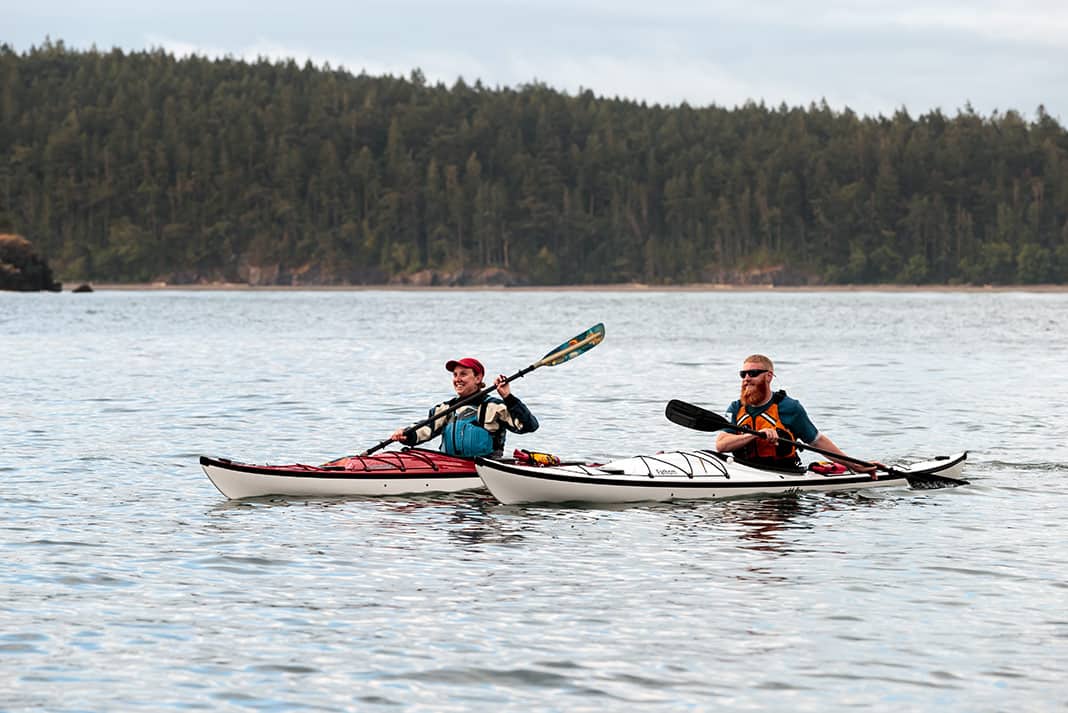
Shell layers
Shell layers help keep a paddler dry and protected from the wind. Both wet and dry clothing systems require shell layers. Wetsuit layers are not wind-resistant and need to be covered with shells to prevent evaporative cooling. Wicking fleece insulation is warmest when kept dry under a drysuit.
Kayaking shell layers are usually waterproof and have seams that are sealed at the factory to prevent leaks. The most versatile shell layers are made from breathable materials. These materials allow some perspiration to escape from the inside of the fabric. This helps keep you drier and more comfortable while paddling.
During vigorous exercise, breathable fabrics can be overwhelmed by perspiration, but none of them feel as sweaty as non-breathable coated fabrics. The best of them are noticeably more comfortable to wear.
Kayaking shell layers have specialized neck, wrist and ankle closures to help keep water out. Neoprene or similar cuffs seal sleeves and ankles more tightly than conventional closures. Even drier are the latex gaskets found in drysuits and drytops. These flexible rubber gaskets fit tightly enough around wrists and neck to keep almost all water out of the suit. Some people find this tight fit too constricting and prefer less watertight closures that can be adjusted for comfort.
A drysuit is the ultimate shell layer for kayaking. It features latex gaskets at the wrists and neck and frequently has waterproof socks that can be worn under paddling shoes. Drysuits made from breathable fabrics can be paired with wicking base layers and insulating layers to provide the broadest range of comfort and cold water protection.
Shell layers for hot weather tend to be focused more on sun protection and comfort than waterproofness. Lightweight nylon paddling shirts and pants aren’t shell layers in the traditional sense of the word, but are good choices for keeping cool when the sun is blazing and water is warm.
What shoes to wear kayaking
Shoes for kayaking fall into two main categories: neoprene footwear and water shoes. Sandals are also worth a mention.
Neoprene footwear includes everything from thin, slip-on wetsuit socks to knee-high waterproof boots. Two big advantages of neoprene footwear are flexibility and warmth. Neoprene insulates when wet and most neoprene booties have a thin sole that fits easily into the cockpits of smaller kayaks. Waterproof neoprene boots are the driest and warmest option. Thin, flexible neoprene booties or socks offer more comfort in warm weather.
Water shoes typically offer less insulation than neoprene footwear, but often have more support. The most minimal water shoes are simple slip-on shoes with a thin sole for protection from sharp objects. Sturdier options have more substantial soles that offer support and padding when walking on shore. The most supportive options have lace-up tops that reach above the ankle. Most water shoes feature sticky soles for grip on slippery rocks. Features like water drains, supportive uppers and low-profile heels are common. Water shoes can be paired with neoprene socks for extra insulation in cold water.
Some kayakers like to wear water sandals in warm weather. Sandals are comfortable on shore, but often uncomfortable in a kayak. The soles of water sandals are typically bulkier than water shoes, so some paddlers may have difficulty fitting them into their kayaks. Since sandals have no padding on the heel, they don’t protect a paddler’s feet from pressure and abrasion.
What about paddling barefoot? Letting your toes wiggle free might have an appeal in warm weather, but it’s better to wear something to protect your feet. Bare feet can develop pressure spots and abrasion during a long day in the cockpit. Worse, bare feet can be cut on unseen hazards while launching and landing. Glass, fishhooks, oysters and other sharp objects can give you a nasty cut. Kayakers are better off wearing some kind of protective footwear, even if it is a thin, lightweight water shoe.
Extra layers
Kayakers should pack extra layers in their boats when they head out for a day on the water. Which extra layers will depend on where you’re paddling and the conditions. Even a hot day can turn windy. Waves and spray can create an unexpected chill. In colder weather or for multi-day tours, a change of insulating layers or base layers can improve comfort and safety. In the worst of weather it might make sense to carry an extra shell layer to wear over your entire clothing system. Whatever the conditions, appropriate spare layers are a good choice. Be sure to pack them in a waterproof drybag so they’ll be dry if you need them.
What to wear under a drysuit and wetsuit
In the paragraphs that follow we’ll discuss what to wear under a wetsuit or drysuit in specific seasons, but it’s helpful to have a few basics down before we start.
Drysuits are meant to prevent water from reaching your skin. By keeping a dry insulating layer between your body and the cold water environment, drysuits offer the most protection from hypothermia.
One big advantage of drysuits is that you can change the insulation worn under them to account for different air and water temperatures. If the water is cold and the air is warm you can wear a thin base layer under your drysuit. If the air and water are both cold you can layer wicking fleece insulation over this layer. The ability to adjust insulation is one of the things that makes a drysuit so versatile.
Some kayakers prefer to wear one-piece insulating suits under their drysuits. These union suits eliminate any possibility of gapping between top and bottom underneath your drysuit, which can be difficult to correct once everything is zipped up. Union suits aren’t as versatile as separate tops and bottoms, but they are extremely comfortable and effective under a drysuit.
Wetsuits are insulation themselves. Many, particularly the thinnest, most flexible options, are intended to be worn directly next to your skin without anything under them. Heavier Farmer John and Farmer Jane style wetsuits leave your arms exposed, so many people find it comfortable to wear a wicking base layer top next-to-skin.
In colder weather, wetsuits can be worn with fleece layers for extra warmth. A typical approach to this might be to layer a Farmer John wetsuit with a base layer top underneath and a fleece top over the wetsuit. Paddling pants and a jacket would be worn over the top of these layers to provide protection from wind and spray. Remember, wetsuits won’t protect you from the wind.
Keeping the basics of layering in mind, we’ll now shift our attention to specific seasons and paddling situations.
Kayaking in different seasons
What to wear kayaking in summer
Dressing for kayaking in the summer can be either a breeze or a challenge, depending on the water temperature. Hot weather and warm water call for a focus on sun protection, but if the water is cold you need to balance comfort in the cockpit with safety in the event of a swim.
In hot conditions with warm water, paddlers should focus on clothing that helps keep them cool and protected from the sun. Wicking base layers with long sleeves provide good coverage and sun protection. Specialized base layers are available with hoods and long sleeves for maximum coverage. Shorts will do in many cases, but long, quick-dry nylon pants offer extra protection from sun and biting insects. Lightweight nylon shirts or hooded tops are another option for sun protection. A broad-brimmed hat is a good choice to keep the sun off your face and neck. Specialized gloves are available to protect hands from sunburn.
If the water is cold, dressing for summer is much more challenging. If you go for a swim in shorts and a t-shirt in Lake Superior or coastal Maine you’ll get hypothermic even if the air temperature is warm. Wetsuits provide enough insulation for a dip in these conditions, but wetsuits are hot to wear when air temperatures climb. There are a couple ways to work around these challenges.
What to wear under a drysuit and wetsuit in summer
If you’re wearing a wetsuit for insulation in summer you’ll want to maximize cooling while you’re in your kayak. Skip the shell layers so that any breeze will help cool your body. Wet yourself down from time to time to keep cool. Some kayakers will roll or dip their head into the water while holding onto a friend’s boat, or even go for a deliberate swim.
If you’re wearing a drysuit in summer, layer thin base layers underneath. You won’t have as much insulation, but you’ll have enough to protect you from all but the coldest water. If you start to overheat, use the techniques suggested above.
What shoes to wear kayaking in the summer
Water shoes are comfortable to wear in the summer, whether you’re paddling in shorts or a drysuit. They provide protection from sharp objects in the water and comfort in your kayak. Neoprene footwear is comfortable in the kayak but hotter on summer days.
Extra layers for summer
Summer storms can bring rain and cooler temperatures. Check the forecast and pack waterproof shell layers and a little extra insulation just in case.
What to wear kayaking in fall
Fall is one of the best times to get out on the water. Cooler days make it easier to dress for immersion and stay comfortable in the cockpit.
In early fall, water temperatures are often warm and air temperatures cool. This unusual set of circumstances makes it possible to dress for maximum comfort. If the water is warm you can layer for comfort in the cockpit and still have enough insulation to protect you should you go into the water. You don’t necessarily need a wetsuit or drysuit. Layering with base layers, fleece tops and bottoms, and paddling jackets and pants is a viable option. Should you go into the water, the fleece will provide a bit of insulation, and once you’re back in your kayak or on shore your body heat will begin to dry your layers. Early fall might be the only season where this approach is appropriate.
Later in the season, or anytime the water is cold, kayakers need to dress for cold water immersion. This means a wetsuit or drysuit and appropriate layers to account for conditions.
Cooler weather calls for different headgear and handwear. As weather cools, a warm hat is a big help. Insulated neoprene gloves help keep hands warm as temperatures fall. A paddling jacket with a hood is a good way to conserve body heat on a windy day.
What to wear under a drysuit and wetsuit in fall
Layering with a wetsuit for fall paddling is similar to layering for summer in cold water. The biggest difference is you’ll need to add shell layers and maybe extra insulation. Waterproof paddling pants and a paddling jacket are key as temperatures drop. Paddling jackets with latex wrists will keep you drier on windy, wavy days, and a hood is a big help if the rain starts pouring down.
If you’re wearing a drysuit in the fall you can vary your base layers and insulating layers to account for air and water temperature. A wicking fleece union suit might be worn by itself under a drysuit, or a base layer top and bottom could be layered with fleece for extra warmth.
What shoes to wear kayaking in fall
Cooler water and cooler air call for warmer footwear. Neoprene booties are a good choice and can be worn over wool socks for extra warmth and comfort. Waterproof neoprene boots will keep your feet dry and are a better choice as temperatures fall. Water shoes can be made warmer by wearing them over neoprene socks.
Extra layers for kayaking in fall
If you’re relying on fleece for insulation in early fall, it’s a good idea to pack an extra set of clothing to change into in the event of a swim. Paddlers using wetsuits might pack an extra fleece top for insulation or an oversized hooded jacket to be worn over other layers. Multi-day trips call for clothing that can be dried on the body or extra layers that can be swapped out in camp. In cold weather, it isn’t a bad idea to take a simple beach shelter like a tarp for protection during breaks, and a thermos with a hot drink to help warm you up.
What to wear kayaking in winter
The obvious challenge in winter kayaking is staying warm. Water temperatures are cold and air temperatures may be even colder. Hands exposed to cold water and air chill quickly. Wind chill and evaporative cooling are more severe. If you go into the water you need serious protection, and with cold air temperatures you’ll have a hard time staying warm once you’re back in your kayak or on shore. Winter paddling calls for extra precautions.
The best option for winter kayaking is a drysuit. Thick wetsuits can provide enough insulation for protection from cold water, and if layered with fleece under a snug paddling jacket they can keep you warm as the air temperatures drop, but drysuits work much better.
Warm, waterproof headwear is key to maintaining body heat. A hooded paddling jacket offers protection from wind and seals in more heat. Thick neoprene gloves are an option for protecting your hands but many paddlers find pogies to be warmer and more useful. Pogies are mittens that attach to your paddle. You can often keep your hands bare under pogies so you have a good feel for the paddle. Some paddlers wear thin gloves under pogies so they have a little protection when their hands are outside the mitts.
What to wear under a drysuit and wetsuit in winter
If you’re layering with a wetsuit in winter, you’ll want to opt for a thick Farmer John wetsuit. You’ll need to layer this with fleece or a thinner long-sleeved wetsuit top. Waterproof shell layers with tight closures are critical. Even with all these layers, expect to be chilled.
Winter layers under a drysuit are similar to those for fall. Thicker fleece layers are a good option. If you have enough room in your suit you can add an extra layer of fleece on your torso for maximum warmth. Sea kayakers can layer an additional hooded paddling jacket over top of their drysuit and PFD. This helps the foam in your PFD act as extra insulation and reduces evaporative cooling.
What shoes to wear for kayaking in winter
Winter calls for waterproof, insulated footwear. Waterproof neoprene boots are a good choice if you’re layering with a wetsuit. Drysuits with integrated waterproof booties are the warmest option. Layer under these with wool socks and over the top with neoprene booties or wet shoes with neoprene socks.
Extra layers for winter
If you’re out in the winter you’re likely wearing lots of layers already. Depending on the length of your trip it might be a good idea to pack an extra set of insulation. An extra waterproof hooded paddling jacket that can be worn over your PFD will help on the coldest days. Spare gloves, pogies and hats are a good choice, as is a simple beach shelter you can use to get out of the weather and a thermos of hot drink to warm you up during breaks.
What to wear kayaking in spring
Spring paddling means cold water and warming air temperatures. This can make dressing for kayaking a challenge. Like summer paddling in cold water, spring requires wearing clothing that will protect you from cold water but also keep you cool when you are in the kayak. Early spring water temperatures are nearly as cold as those in winter, and require similar precautions.
Spring paddling is particularly hazardous because it’s easy to let warm air temperatures trick you into paddling in clothing that isn’t up to the job. A spring paddle in shorts and a t-shirt might be tempting, but could turn tragic. Cold water will give you hypothermia regardless of how warm the air is. Make sure you dress appropriately for the water temperature, not the air temperature.
What to wear under a drysuit and wetsuit in spring
If you’re using a wetsuit for protection from cold water in the spring you’ll need to layer for warmth if you go into the water. That means more insulation, and shell layers if the wind is blowing. These extra layers can cause overheating on a warm day, so you need to have a strategy for keeping cool while you’re in your kayak. Dunking your head or wetting your wetsuit helps. If the air temperatures are warm you can leave your shell layers off and let a little evaporative cooling work to keep you comfortable.
Of course, on a cold spring day you’ll likely have all your layers on—a wetsuit, extra fleece, paddling jacket and pants. A cold day in the spring can be a lot like a warm winter day. Plan accordingly.
Under a drysuit you’ll want to choose layers that are similar to those you would wear in fall. Thin wicking fleece or fleece over a wicking base layer are a good choice. The warmer the weather, the thinner your insulating layers should be.
What shoes to wear kayaking in spring
Spring paddling means cold water. This means that you’ll want to wear footwear that will keep your feet warm and protected. Waterproof neoprene boots offer the most protection, followed by insulated neoprene booties. If you have a drysuit with booties you’ll have toasty dry feet. Layer with wool socks underneath and booties or water shoes over the top.
Extra layers for kayaking in spring
Pack all your extra layers for spring paddling. You might start out the day paddling in your wetsuit and base layers and end it buttoned up in paddling jacket, pants and an extra fleece. Pogies, gloves and a warm hat don’t take up much room in a drybag and add lots of warmth in a pinch. As with winter and fall paddling, a tarp to hide under for breaks can be a welcome relief if the wind starts to blow, and it’s always nice to sip a hot drink if the weather turns cold.
Different types of kayaking
What to wear sea kayaking
The biggest difference between sea kayaking and other types of kayaking is that sea kayakers tend to spend more time in their kayaks and paddle in a wider range of conditions than other paddlers might. If you’re sea kayaking, you might paddle out through the surf, spend several hours on the water in wind and waves, and make camp at the end of the day under a tarp. Sea kayakers need clothes that protect from conditions like those found on a whitewater river, but also allow for ventilation and comfort during a long day of paddling. They need to be able to wear the same clothes for several days because there is a minimum of space in their kayaks for extra layers. These challenges make choosing clothing for sea kayaking more complicated than it is for everyday paddling.
The perfect combination of clothing for sea kayaking would allow good freedom of movement for forward paddling, protection from cold water and comfort on warm days. For many sea kayakers this means wearing a drysuit rather than a wetsuit. Drysuits are less restrictive than wetsuits. They reduce chafing and improve comfort over a long day (or week) of paddling, and they make it easier to take a single set of insulation with you on an extended trip.
Many sea kayakers prefer paddling jackets with hoods for added protection in wind and rain and some choose drysuits with this feature.
Sea kayakers who prefer the economy of wetsuits will frequently choose paddling jackets with adjustable necks for improved ventilation. Paddling jackets with latex wrist gaskets are drier in wind and waves.
One specialized piece of paddling clothing that sea kayakers often choose is a storm cag. This large, hooded jacket is cut to be worn over the top of all your other protective clothing and your PFD. Worn this way, the cag protects from wind, rain and chilling temperatures. Kayakers who are considering a drysuit for both sea kayaking and whitewater use might choose to add a storm cag to their layering system rather than purchasing a drysuit with a hood.
What to wear whitewater kayaking
Whitewater kayaking is wet. Holes, wave trains and ledge drops throw a lot of water at a whitewater kayaker. Many whitewater kayakers can roll their kayaks and need clothing that will keep them dry if they turn upside down and come back up again. This puts an emphasis on dryness in whitewater shell gear.
Drytops that have a latex neck gasket are common as are drysuits for cold weather paddling. These frequently feature a double tunnel design that securely seals that gap between the paddler and sprayskirt to prevent water from entering the kayak during rolls or in turbulent water.
Summer whitewater kayaking can combine cold water with warm air temperatures. This means drysuits for some paddlers and short-sleeve paddling jackets worn over wetsuits for others. A short-sleeve paddling jacket helps keep water out of a kayak by sealing the gap between sprayskirt and paddler, particularly if the jacket has a double tunnel design like a drytop.
Drytops are common for whitewater paddling, but so are semi-drytops. Semi-drytops have all the features of drytops but replace the latex neck gasket with a tight sealing neoprene collar. The neoprene neck closure isn’t as dry as a latex gasket, but many paddlers find it more comfortable.
One consideration for whitewater gear has to do with padding and durability. Whitewater kayaking puts more wear on clothing and a swim in the river might involve bumping into a few rocks. Wetsuits provide a little padding in the event of a swim. Many whitewater kayakers prefer them for this reason, especially as they’re building their skills and perfecting the kayak roll. Similarly, whitewater clothing is frequently sewn from tougher material to help protect the paddler from abrasion and improve durability.
Footwear for whitewater puts an emphasis on traction and protection. Sturdy water shoes with sticky rubber bottoms are common. These offer welcome support when hopping from rock to rock or carrying your kayak over a rough portage.
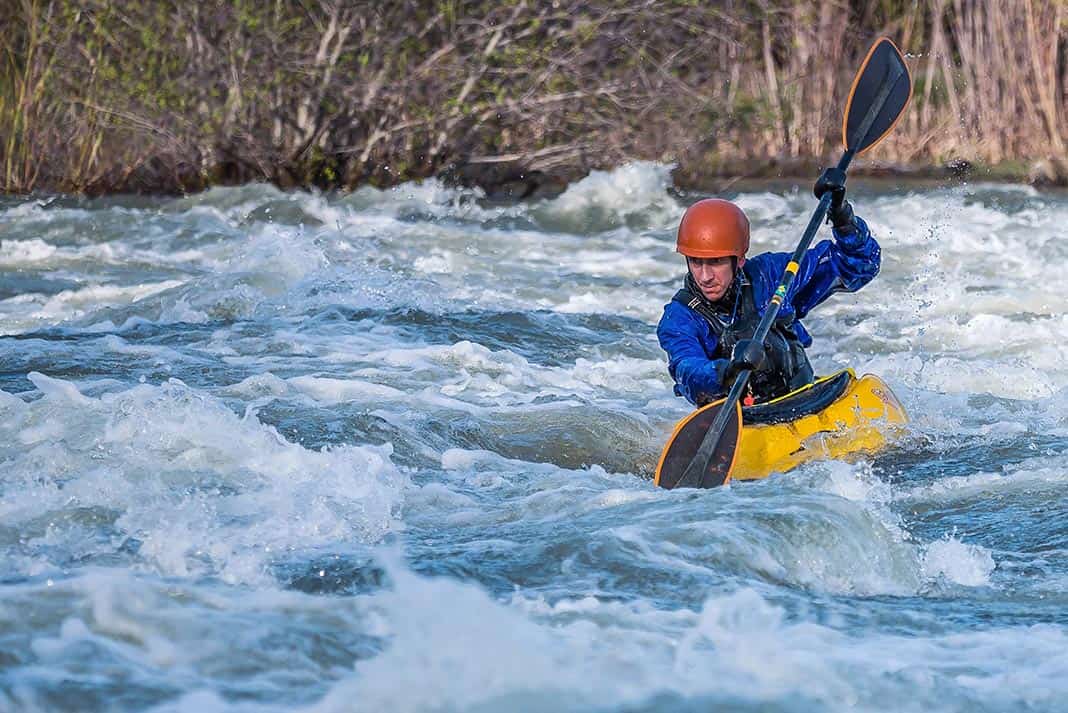
What to wear kayak fishing
For many kayak fishing enthusiasts, the emphasis is on fishing, rather than kayaking. The kayak is a tool for accessing productive water, especially water that would be hard to get to in a larger boat.
This focus on the fish means clothing choices for kayak anglers tend to tilt toward comfort and angling function rather than maximum cold water protection. This, coupled with the fact that the fishing is often better when the conditions are calm, means kayak anglers don’t necessarily need to dress for cold water in the same way sea kayakers or whitewater kayakers might.
Of course, kayak anglers heading offshore in cold water situations need to follow the same guidelines other kayakers do when it comes to appropriate clothing; but kayak anglers also have to account for comfort and versatility when they’re on the water targeting fish.
The most popular fishing kayaks are sit-on-top designs. These boats are more open and exposed to the elements than closed-cockpit, sit-inside designs. This means kayak anglers need to pay particular attention to clothing that protects their whole body from inclement weather or blistering sun. Long sleeves and pants for sun protection are a good choice. When the wind picks up and the rain starts, kayak anglers will want to be covered up in waterproof paddling jackets and pants. Waders or waterproof bibs offer lots of waterproof coverage and help eliminate gapping between top and bottom. Hooded jackets offer the best protection from wind and rain, and large pockets are handy for stashing gloves or a warm hat.
Footwear for kayak fishing should be matched to the season, with cold water calling for waterproof neoprene boots and hot sun favouring lightweight water shoes.
Kayaking in different weather
What to wear kayaking in the rain
Kayaking in the rain can be some of the most pleasant time on the water. Or it can be downright miserable. The right clothing makes all the difference.
Closed-cockpit kayaks fitted with sprayskirts stay remarkably dry in the rain. Open sit-on-top designs are much more exposed to the elements. The right clothing for each will help you stay comfortable if it starts to pour when you are on the water.
In a closed-cockpit kayak, the most important piece of clothing you can wear is a hooded paddling jacket that fits tightly over your sprayskirt. The skirt seals your lower body from the rain so you’ll stay dry and warm from the waist down. The paddling jacket keeps your upper body dry and comfortable.
If you’re paddling a sit-on-top design, you’ll need waterproof paddling pants as well as a jacket. In this case, it’s better to choose a jacket that is a little longer at the waist so your top overlaps your pants and prevents any gaps where water could trickle through. Paddling bib pants or waders are another good way to get extra protection from rain and spray, and they’ll keep your feet dry if you step into the water. Waterproof neoprene boots are a great choice for keeping your feet warm and dry in rainy weather.
Sea kayakers wearing drysuits have a couple options for rainy weather. A broad-brimmed waterproof hat will keep the water out of your eyes on a warm day. In colder weather, rain might call for adding a hooded waterproof jacket over the top of your drysuit and PFD.
Whitewater kayaking in the rain is a lot of fun. Drytops and whitewater helmets do a good job of protecting the paddler from rain, and a neoprene sprayskirt seals the kayak up tight.
What to wear kayaking on a sunny day
Sunburn is a hassle at best and a real hazard in the worst cases. Being close to the water intensifies UV exposure, even on cloudy days. If you’re spending a lot of time on the water you’ll want to make sure to protect yourself from the sun.
Lightweight, long-sleeve tops and quick-dry pants are a good place to start. Some specialized base layer tops have hoods for full coverage and thumb loops that keep sleeves down over your hands. Wide-brimmed hats, neck gaiters and gloves provide extra protection. Make sure to protect the underside of your neck and legs. Sunlight reflecting off the water can give you a burn where you’d least expect it.
Complete list of kayaking apparel
PFDs
Technical outerwear
Wetsuits and neoprene
Footwear
Top kayaking apparel brands
The best place to go looking for high-quality kayak clothing is from a recognized and respected paddlesport clothing manufacturer. Companies that specialize in kayak clothing do the best job designing garments that fit well and keep you comfortable on the water. They have the most experience with different materials and a proven track record of supplying quality gear to kayakers. They also offer top-notch customer service and stand behind everything they make. A few of the top kayak apparel brands can be found at the links below.
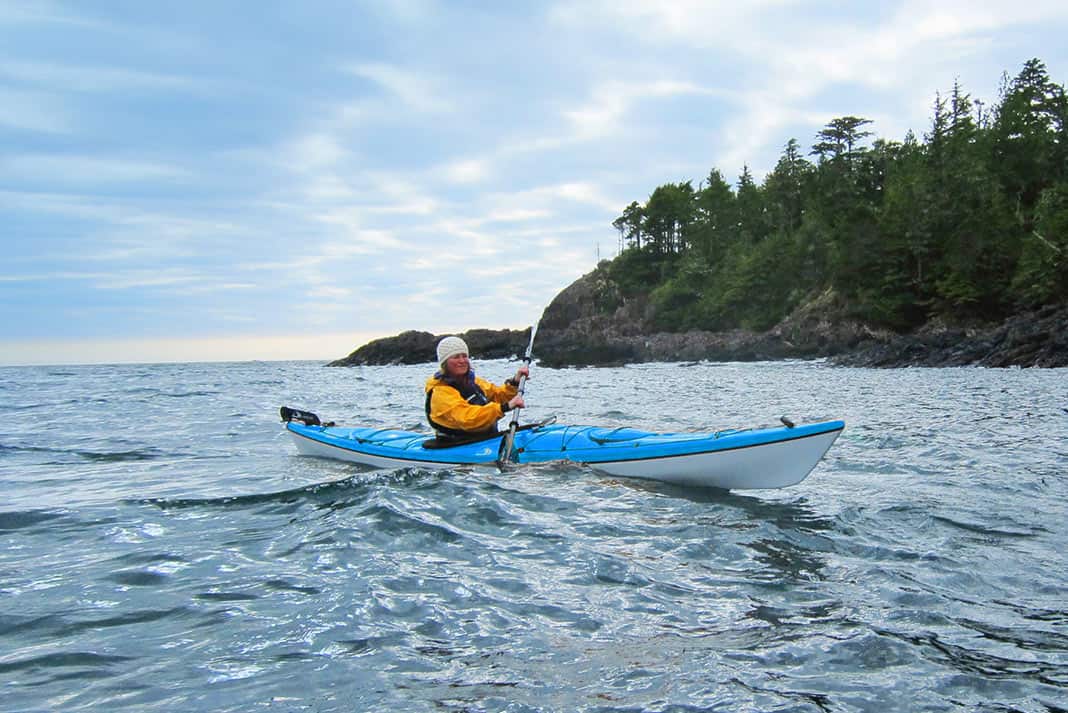
Kayaking apparel reviews
Here are a few pieces of kayaking apparel our team at Paddling Magazine has reviewed:
Drysuit reviews
- NRS Crux Drysuit
- Level 6 Fjord and Trident Drysuits
- Kokotat Men’s and Women’s Icon Drysuit
- Level Six Men’s Triton Drysuit
- Stohlquist Women’s Amp Drysuit
- Kokotat Idol Drysuit
Drysuit liner reviews
Mitts reviews
Jacket reviews
Where to buy kayaking apparel
Paddling Buyer’s Guide
The Paddling Buyer’s Guide has the widest selection of kayak clothing with hundreds of products from hundreds of trusted clothing brands. Shop by category and filter by just about anything that would be a deal maker or breaker. Then click through to buy direct or find a dealer near you. Shop now.
REI
The paddling section of your local REI and the online shop at REI.com offer a wide range of paddling clothing—not everything from every brand, but a good selection of gear from top-quality manufacturers. If you can’t find what you’re looking for at REI, wander into the neighbouring local paddling shop—they will probably have the rest.
Amazon
Sure, you can buy kayaking clothing on Amazon. Lots of people do. That said, most core kayak clothing companies would prefer to see their products sold through specialty kayaking shops where knowledgeable sales teams can outfit paddlers with expert advice. If you are shopping for paddling clothing on Amazon, be wary of inflated consumer reviews and fake copies of authentic paddling brands. Buy from trusted retailers on Amazon. Pay attention to return policies. Double-check shipping fees. And don’t go try gear and accessories at your local paddling shop and then buy it on Amazon—support local retail.
Walmart
You’ll be hard-pressed to find good kayaking clothing at Walmart or any other mass merchant. Yes, there may be some fleece or base layers that could work in a pinch, but they won’t be cut for comfort while paddling and they won’t be built to last. On top of this, the sales staff at these stores won’t be able to help you with real questions about kayaking gear. Skip the big box stores if you’re looking for the right gear to keep you comfortable and safe on the water.
Local retailer
If you have a good kayak shop in your hometown, count your lucky stars. In fact, if you have one within a two-hour drive it’s worth the trip. Local retailers paddle local waters, know the ins-and-outs of your region and will have the best recommendations for paddling clothing that works where you live. Often, local shops will curate their offerings based on what they know works from personal knowledge. Your local shop may not have every piece of clothing mentioned in this article, but they will know how to get whatever you need. Better still, they’ll likely offer classes, tours or meetups to get you out on the water and introduce you to the paddling community in your town.
As a United Stated Coast Guard nonprofit grant recipient, the Water Sports Foundation produces paddling safety outreach materials and distributes them through boating and paddling media providers. Paddle sports currently has an inordinately high rate of accidents and deaths that for the past five years has been increasing, while power boating stats have been decreasing during the same period. The goal is to create heightened public awareness of safer paddling making paddle sports safer and to ultimately reduce the total number of paddle sports related deaths annually.




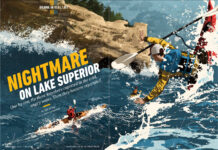
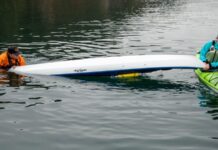
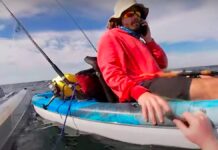


One comment about footwear: bigger feet on taller kayaks mean bigger boots in some cases. Depending upon the cockpit height of the traditional kayak, too thick of a heel can limit the room you have to properly position your feet (if the deck/cockpit height is too short). Sometimes wearing a bootie without raised heel is better. You can add a cushioning pad onto your deck hull floor where your heel rests for more comfort. Also,what’s your typical landing sites like? Soft sand or rocky shoreline….different soles (hard, soft, smooth, treaded) all make a difference in how securely and comfortably you can walk once ashore. Sometimes you need to bring an extra set of boots along, one for paddling, one for extensive shoreside walking. Be Smart, Be Safe, Have Fun!